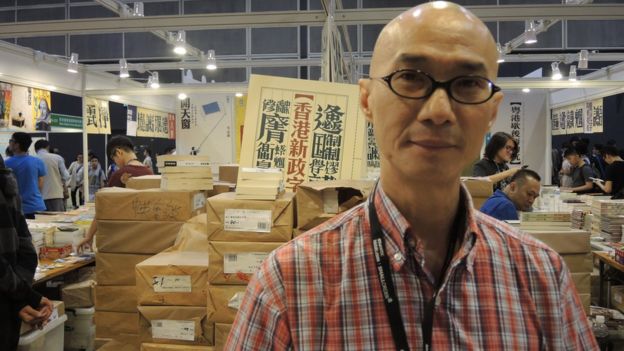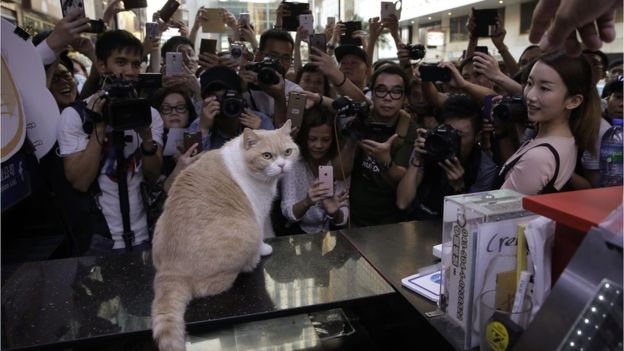Political vocabulary and Brother Cream
« previous post | next post »
BBC News has a nice article by Tzu-Wei Liu on "The politics of a martial arts book fair in Hong Kong" (7/26/16). The article is accompanied by six photographs; I will focus on the two that interest me most (because they are both language related), the third and the sixth.
Here's the third photograph:
It shows Pang Chi-ming, chief of the local publishing company Subculture Ltd, who is standing in front of a display for the hot-selling book, Hong Kong's New Political Vocabulary. This is a dictionary featuring around 150 new Chinese characters (not words) made up by the authors. Behind Pang in the photograph, the Chinese title of the book may be seen: Xiānggǎng xīnzhèng zì 香港新政字 (New political characters for Hong Kong). The article describes the contents of the book thus:
The authors argue that recent social movements such as the pro-democracy Occupy Central protests have created a new, more defiant language in Hong Kong.
Fair enough. But then the article continues:
Because Chinese characters are pictographs, the authors replaced the components of existing Chinese characters to give them complex new meanings.
Chinese characters are overwhelmingly not pictographs and, judging from the newly created characters visible on the poster in the background, it is more a question of creating entirely new characters rather than replacing the components of existing characters. For example, one of the new characters consists of guó 国 ("country") on the left and two zhì 制 ("system") — one placed on top of the other — on the right side. If you ask me how to pronounce this new character, in Mandarin I would say "yīguóliǎngzhì 一国两制" ("one country two systems"), making it another of those polysyllabic characters that we have studied before:
- "Polysyllabic characters in Chinese writing " (8/2/11)
- "Polysyllabic characters revisited " (6/18/15)
- "A new polysyllabic character" (7/3/16)
I invite Language Log readers to interpret some of the other new characters on the poster or, for those who are in Hong Kong, perhaps someone can go over to the Book Fair and buy a copy to see what other treasures are inside.
The sixth and last photograph in the article is this:
That's handsome, pudgy Brother Cream (b. 2005), my friends, and he just happens to be the most famous cat in Hong Kong. Brother Cream, a male British Shorthair, has several aliases and nicknames, but his formal name is Tsim Sha Tsui East Brother Cream (Cant. Zim1dung1 Gei6lim4 Go1; Mand. Jiāndōng Jìlián Gē 尖東忌廉哥 / 尖东忌廉哥). Do not try to make sense of 忌廉 (lit., "avoid / shun / abstain from incorrupt"); it is the Cantonese phonetic transcription — gei6lim4 — of English "cream".
This reminds me of a funny story about my son and his maternal grandma, my mother-in-law. When he was about two years old and fluent only in Mandarin, his wàipó 外婆 took him to the nearby McDonald's, and he asked her to buy him some bīngqílín 冰淇淋 (that's the Mandarin word for "ice cream"). My mother-in-law didn't speak a word of English, but she knew that the latter part of "bīngqílín 冰淇淋" was a foreign word, so she very cleverly thought to herself that she'd just say the "qílín 淇淋" (transcription of English "cream") part with what she perceived to be a foreigner's "twist". So she walked up to the counter and announced confidently: "binkteelink!" At first the person at the counter was dumbfounded, but she kept repeating the word and making animated gestures, so finally my son got what he wanted.
I could tell endless stories of this sort about my mother-in-law and my son when he was a little boy, but will save them for another occasion.
But why is Brother Cream the star of the Hong Kong Book Fair?
It helps that he has 43,800 followers on Instagram and around 200,000 "likes" on Facebook, has his own PR manager, has appeared in advertisements and on TV, etc., etc. Moreover, Brother Cream has already had two books published about (by?) him (2012, 2013). So it is no surprise that his biography, which just came out, is one of the top sellers at the Book Fair. Indeed, it may well outsell Hong Kong's New Political Vocabulary, whose authors and publisher might just be disappeared, together with their stock, before the fair comes to a close.
[h.t. Carmen Lee]


WSM said,
July 27, 2016 @ 5:32 am
Clearer shot of the cover and some contents: http://topick.hket.com/article/1466801/書展有咩睇?%E3%80%80「合文字」你聽過未-
WSM said,
July 27, 2016 @ 5:44 am
Also I'm curious why at least some of these new polysyllabic characters, specifically, could not be considered "words"?
Victor Mair said,
July 27, 2016 @ 8:15 am
This is a dictionary of or book about zì 字 ("characters"), not cí 詞 /词 ("words"). Like any zìdiǎn 字典("character dictionary"), some of the characters may also function as words. See the brilliant analysis of "bound" and "free" in Concise Dictionary of Spoken Chinese (1947) by Y. R. Chao and L. S. Yang, which makes the distinction between character and word very clear (see this comment, the second part of this comment, and the fourth paragraph of this comment). Even my favorite Chinese character dictionary, the Xīnhuá zìdiǎn 新华字典, which has sold hundreds of millions of copies, about a dozen of which I have stashed around in various corners of my house, office, and luggage, is aware of the distinction, as is, of course, the Xiàndài Hànyǔ cídiǎn 现代汉语词典, which is the standard desktop word dictionary in Mainland China.
Indeed, some of the characters in Xiānggǎng xīnzhèng zì 香港新政字 (New political characters for Hong Kong) may also function as words or, as in the case of the one I explained as meaning "yīguóliǎngzhì 一国两制" ("one country two systems"), as phrases. But the book itself is fundamentally about characters, not words or phrases.
Victor Mair said,
July 27, 2016 @ 9:31 am
@WSM
Thank you for the link in your first comment. It is very helpful for understanding what Xiānggǎng xīnzhèng zì 香港新政字 (New political characters for Hong Kong) is all about.
First of all, the article describes the contents of the book / dictionary as being about héwénzì 合文字 ("compound characters"). If we do a Google search on that term, or a Google search on the shorter form héwén 合文 ("conjoint writing"), we will see that such polysyllabic characters are not at all uncommon, and that people are constantly looking for ways to collapse several characters into one.
Sometimes héwén 合文 are referred to as hézì 合字, for which there is a standard English translation, "ligature". The English Wikipedia article on this subject even has a special section on "Chinese ligatures".
Second, judging from the three examples given in the article, the authors have followed traditional lexicographical methods by describing each new character according to the following criteria:
xíng 形 ("shape; form"), which explains clearly the composition of each character, i.e., its constituent parts
yīn 音 ("sound"), i.e., the pronunciation in Cantonese
yì 義 ("meaning"), i.e., the definition and explanation
Third, just looking at the three sample characters pictured in the article and on the cover of the book, it would seem to me that the authors and publishers are treading on very dangerous territory in a Hong Kong that is increasingly coming under the scrutiny of the authorities in the PRC.
WSM said,
July 27, 2016 @ 10:46 am
agreed – the contents seem quite provocative. I hope that the book makes it to safer shores at least in Taiwan so us outsiders can order it :)
Daniel Tse said,
July 28, 2016 @ 12:35 am
Victor, I believe 忌廉 is pronounced gei6 lim1 and not gei6 lim4 in an instance of the bin3jam1 ("sound change") phenomenon.